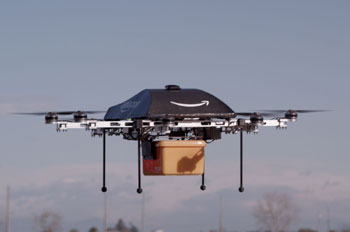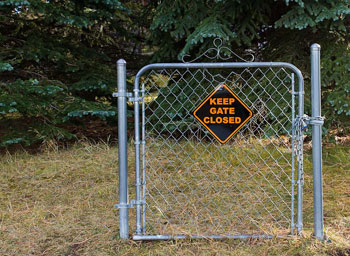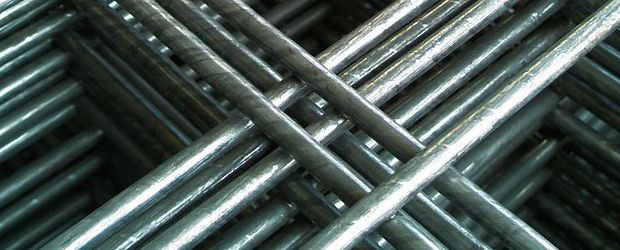Jon Bruner
Inside Solid: what won’t drones do?
How Moore's Law applies to drones — a backchannel meditation on drone limitations.
 Extrapolation is great fun — especially over technology, where Moore’s Law has conditioned us to expect exponentially falling costs and fast adoption. Applied to drones, extrapolation might lead us to conclude that they’ll fill the skies soon, delivering anything we want on demand. They are, after all, rapidly getting cheaper and smarter, and drone-related announcements get tons of press.
Extrapolation is great fun — especially over technology, where Moore’s Law has conditioned us to expect exponentially falling costs and fast adoption. Applied to drones, extrapolation might lead us to conclude that they’ll fill the skies soon, delivering anything we want on demand. They are, after all, rapidly getting cheaper and smarter, and drone-related announcements get tons of press.
So, where will the drones stop? A few of us meditated on the limitations of drones last week on news that Facebook plans to use them to provide Internet connections to those who don’t have them, and on DHL’s announcement that it would begin making deliveries by drone to the island of Juist, in the North Sea. An edited excerpt of our exchange follows. Read more…
Stop hacking random stuff. It’s getting trivial.
Once we acknowledge nearly everything is insecure, we can engage in a more nuanced discussion about security.
 I was gratified to read Dave Aitel’s rant about junk hacking last week [via Peter Lewis and abridged below]:
I was gratified to read Dave Aitel’s rant about junk hacking last week [via Peter Lewis and abridged below]:
“Yes, we get it. Cars, boats, buses, and those singing fish plaques are all hackable and have no security. Most conferences these days have a whole track called ‘Junk I found around my house and how I am going to scare you by hacking it.’ That stuff is always going to be hackable whetherornotyouarethecalvalry.org.
…
“Yes, there is Junk in your garage, and you can hack it, and if
you find someone else who happens to have that exact same Junk, you can probably hack that, too, but maybe not, because testing is hard.“Cars are the pinnacle of junk hacking, because they are meant to be in your garage. Obviously there is no security on car computers. Nor (and I hate to break the suspense) *will there ever be*. Yes, you can connect a device to my midlife crisis car and update the CPU of the battery itself with malware, which can in theory explode my whole car on the way to BJJ. I personally hope you don’t. But I know it’s possible the same way I know it’s possible to secretly rewire my toaster oven to overcook my toast every time even when I put it on the lowest setting, driving me slowly but surely insane.
“So in any case, enough with the Junk Hacking, and enough with being amazed when people hack their junk.”
Inside Solid: who will build the “god platform” for the Internet of Things?
Everyone is racing to build the topmost layer for home automation.
Everyone’s racing to build the “god platform” for the Internet of Things: the highest, most generalized layer of intelligence and user interface that ties together connected devices and web services.
It’s tempting to look for analogy in mobile phone platforms, where Apple was initially dominant and now enjoys an extremely lucrative and influential minority position against Android. There are some crucial differences, though. For starters, adoption won’t be quite as easy; domestic appliances last for a long time, and nothing consumers have seen yet makes connected laundry seem appealing enough to justify early replacement of a washing machine. And even in cases where replacement is relatively easy, the grandest promises entail stitching everything into a seamless system — replacing just the easy stuff can seem pretty lame. Read more…
Talking to big machines
What “design beyond the screen” means for the industrial Internet.

GE’s 3.2-103 wind turbine analyzes tens of thousands of data points every second and communicates seamlessly with neighboring turbines, service technicians, and operators.
Design beyond the screen is a much broader and more transformative concept than just that, though: it encompasses changes in the relationships between humans and machines and between machines and other machines. Good design beyond the screen makes interaction more fluid and elevates both people and machines to do their best work. The impact of good design beyond the screen could be huge, and could extend well beyond consumer electronics into heavy industry and infrastructure. Read more…
Why PayPal jumped the software-hardware gap
A software company reaches into the physical world with hardware.
PayPal is a software company, but when I met with Josh Bleecher Snyder, director of software engineering at PayPal, it was to talk about hardware. He’s leading the development of Beacon, PayPal’s new hands-free payment platform. At its heart is a finger-size stick that uses Bluetooth Low Energy to connect with mobile phones and confirm identity.
Paypal’s move into hardware extends its software into the physical world — a key idea behind our Solid Conference. What was once a system confined to screens and keyboards is now part of a new set of interactions in brick-and-mortar stores.
Beacon is part of a vast PayPal stack, and Bleecher Snyder’s team solved problems with a blend of hardware and software thinking — writing code in Go that was efficient enough for Beacon’s processor to be underclocked and avoid overheating, and to anticipate attacks on PayPal’s service that might come from compromised hardware. His entire system hews to PayPal’s “don’t be creepy” mantra by quickly and permanently discarding data that isn’t used in transactions. Read more…
The IT-OT convergence
The key to brilliant factories lies in the combination of information technology and operations systems, says GE's CIO.
Solid is about the intersection of real and virtual — the idea that, through sensors, networks, and intelligent machines, information can move fluidly between software and the physical world. It’s easy to see the technical implications of that intersection — thermostats that adjust themselves and cars that can drive autonomously — but there’s also a crucial management implication as well. Just as design can be automated and optimized if it’s encapsulated in software, a company’s operations can be made much more efficient if they’re modeled digitally before being executed.
Jamie Miller, senior vice president and chief information officer at General Electric, calls that “IT meets OT” and sees the combination changing her industry. “When you take these two disciplines that used to be separate and combine them, you can start to approach engineering and design differently, operate workflow differently, make factories brilliant.” It’s a philosophy that GE uses internally and builds into the products it sells.
Companies like GE have a lot of data — digital designs for manufactured parts, human-resources records, work orders from customers, service manuals — and this data tends to converge on human operators. A field technician might receive a work order to fix a wind turbine, visit the machine, consult documentation, call a colleague for specialized advice, order a replacement part, and finally make the repair. Read more…
The automation of design
Physical and biological design are about to get much more digital, says Autodesk’s CTO.

A titanium chair designed through iterative generation and optimization by Autodesk software. Photo courtesy of Autodesk and The Living.
One of the core ideas behind our Solid Conference is that software can replace physical complexity, and that it’s getting easier for it to do so because the relationship between the physical and virtual worlds is becoming more fluid. Input tools like 3D scanners and computer vision software, and output tools like CNC machines and 3D printers are essentially translators between digital and physical. They make it possible to extract information from physical objects, compute on it, transform it, combine it with other data, and then “rematerialize” it.
I recently spoke with Autodesk CTO Jeff Kowalski about this convergence between physical and digital, and its impact on design. In his view, computers are about to go from mere drafting tables to full partners in the design process. They’ll automate the tedious cycle of trial and error, and leave designers to guide aesthetics and experience. “Decades ago, someone came up with the term ‘computer-aided design,’ but what we’ve had up to now is really computer-aided documentation,” he says. “Design has been accomplished solely in the head of the designer, and then the computer is used to document the outcome.” Read more…
A Solid preview
Design in the hardware era, how big companies and small companies should interact, and the importance of data privacy
Our new Solid conference is less than a week away. To tide you over, here’s a Solid video from a combined SFIoT, SF Hardware, and Sensored (SF) Meetup.
On stage, along with myself, are three Solid people: Rachel Kalmar, data scientist at Misfit Wearables and member of our program committee; Mike Kuniavsky, principal scientist at PARC and speaker on Functional Forms at Solid; and Dan Saffer, creative director at Smart Design, who will speak about microinteractions (and has written an O’Reilly book about microinteractions as well). Read more…
What’s a tech company, anyway?
Talk of the "tech sector" is out of date. Every company is a tech company.
Uber has encountered a series of challenges that are notionally unfamiliar to the current generation of tech companies: wrongful-death lawsuits, rent-seeking by an entrenched industry, regulatory scrutiny from local bureaucrats, worker protests. The company admitted to having disrupted a competitor’s operations by calling its cars, then canceling. No matter how explicitly it warns about surge pricing, riders accustomed to a certain way of booking a car ride object.
There’s an established industry that charges people for rides in cars, and it’s been reduced to a set of straightforward points of competition: price, car quality, ease of booking, and — treacherously for Uber and uncharacteristically for “tech companies” in general — the burly and distasteful accumulation of political clout before municipal taxi commissions. Read more…
Biology as I/O
Solid's long view includes biology as part of the creator's toolkit.
Tim O’Reilly subjected himself to an engaging Ask Me Anything session on Reddit earlier this week. The focus of the exchange was the Internet of Things, in anticipation of our Solid conference taking place next month.
We’re always listening for faint signals from our community about what they’re getting interested in, and one area that’s stood out to us is biology, which is becoming easier to experiment with at home, as a hobbyist, and through hackerspaces like Biocurious and Genspace. You’ll find a few threads on biology at Solid this year, but we’ve tagged it to be a little more central at Solid 2015. Beyond the hobbyist and health-related applications, we see synthetic biology as another way to translate between virtual and physical, like 3D printers and stereoscopic cameras.
Here’s an exchange from Tuesday’s Reddit thread that sums it up nicely.
What prompted the start of BioCoder? Are people really doing biotech in their garages in the same way that many computer hardware and software innovations happened?
Thanks.

